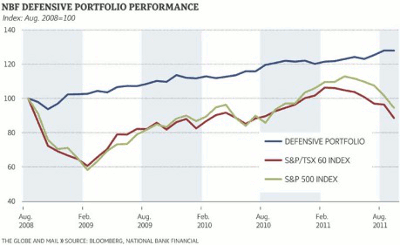If you mind the upside, the downside takes care of itself with this ETF-based defensive strategy, writes Rob Carrick, reporter and columnist for The Globe and Mail.
Cash is king in uncertain times for financial markets, but what a royal pain it is for investors.
In return for bulletproof safety, you get returns below the 1% mark. What if you could crank up your returns substantially in up and down markets, while still keeping risk contained?
This is exactly the result achieved by the Defensive ETF Portfolio designed by analysts at National Bank Financial. This grouping of eight exchange traded funds was up 4.8% for the year through September 30 on a total return basis (bond interest and dividends plus ETF price changes), while the S&P/TSX 60 index of big blue chips was down 11.6%.
The last time the stock market crashed, the portfolio was even more dramatically effective. For the 12 months starting September 1, 2008, it gained 8.5% while the 60 index fell 18%.
"The Defensive ETF Portfolio is for times when crisis hits," said analyst Pat Chiefalo of National Bank Financial. "You would look to something like this at times when we have something mirroring the 2008-09 time frame."
A few months ago, Chiefalo and his colleagues were looking at the markets and wondering if something along those lines was happening again. That set them to work looking for ETFs that outperformed on a relative basis during the financial crisis, which essentially means they lost the least money.
It turns out that some ETFs actually made money during the peak of the crisis, which the NBF analysts defined as September 2008 to September 2009. These ETFs were gathered together in the defensive portfolio, which showed its stuff again in the most recent stock decline.
|pagebreak|Bonds are the backbone of the defensive portfolio, with a weighting of 58%. An ETF that covers the entire bond market is the biggest holding, with smaller amounts going into a corporate bond ETF and a short-term bond ETF. Corporate bonds add a little extra yield with additional risk, while short-term bonds do just the opposite.
The 31% position in stocks suggests more risk than there actually is, because about 12% of the portfolio is in preferred shares. Preferred shares are mainly a vehicle for generating dividend income, and they don’t jump around in price as much as the common shares that make up most of the stock market.
Small positions in gold and consumer-staples stocks are also included in the defensive portfolio—but that’s it for stocks.
This lack of broad stock-market exposure suggests the Defensive ETF Portfolio is not an ideal portfolio for all financial conditions. "It’s excessively defensive," Chiefalo said. In a bull market for stocks, "you’d want to crank up your market exposure."
Rounding out the defensive portfolio is a 6% position in an ETF that does the same job as a money-market fund, and a 5% weighting in a gold bullion ETF.
The Defensive ETF Portfolio is designed more to preserve your portfolio than to grow it. But it also teaches us a lesson about investing in markets with violent ups and downs: Pay more attention to limiting losses when the market is falling than to positioning yourself for gains when the market is rising.
Even while underperforming the stock market badly in 2009 and 2010, the defensive portfolio produced a cumulative total return over the three years to September 30 of 27.9%. The 60 index, by comparison, was down 11.4% over that period. You might say that by minding the downside, the defensive portfolio let the upside take care of itself.
This past September, the portfolio once again stood up well in a falling stock market. Its gain of 0.1% during the month compares to an 8.1% drop for the 60 index.
Despite its consistent resiliency in down markets, it’s important to realize that the Defensive ETF Portfolio is not virtually loss-proof, like cash is. The portfolio’s maximum drawdown, or biggest one-time decline, over the past three-year span was 7.7%, which looks good only in comparison to the 60 index’s maximum drop of 43.4%.
With its heavy weighting in bonds, the defensive portfolio is vulnerable to rising interest rates (bonds and bond funds fall in price when rates rise). The 14.3% weighting in gold will be a drag at times like now, when gold prices are falling.
In fact, gold was the biggest drag on the defensive portfolio in September. The gold bullion ETF in the mix, the Horizons BetaPro COMEX Gold ETF (IGT), fell 4.9%, and the ETF that tracks gold stocks, the iShares S&P/TSX Global Gold Index Fund (XGD), fell 5.7%.
Still, gold is widely considered to be a top defensive choice for investors, and it was in fine form during the 12 months starting in September 2008. The gold bullion component of the defensive portfolio gained 17.9% during that period, while gold stocks rose 8.6%.
One thing you won’t find in the defensive portfolio is much foreign content. Global exposure comes in at just 3% of the whole—roughly 2% in the United States and 1% internationally.
"It is prudent to reduce exposure to international and emerging markets, which tend to be the most volatile during periods of market upheaval," Chiefalo and his colleagues say in a summary of the defensive portfolio’s recent performance.
One last advantage for the defensive portfolio over cash is its much fatter stream of income. The yield on the portfolio over the past 12 months was 2.9%, and it’s generated through a mix of interest income from the three bond ETFs in the mix, and dividends from the preferred-share and consumer-staples ETFs.
Cash? A one-year Government of Canada Treasury Bill now yields about 0.9%. Some king.
Breaking Down The Defensive ETF Portfolio
Here are the exchange traded funds that make up the Defensive ETF Portfolio. Each was selected on the basis of having delivered positive returns during the stock-market sell-off from September 2008 to September 2009.
Stocks
Claymore S&P/TSX CDN Preferred Share ETF (CPD)
iShares S&P/TSX Global Gold Index Fund (XGD)
iShares S&P/TSX Capped Cons. Staples Index Fund (XST)
Bonds
iShares DEX Universe Bond Index Fund (XBB)
iShares DEX All Corporate Bond Index Fund (XCB)
iShares DEX Short Term Bond Index Fund (XSB)
Alternative Investments
Horizons BetaPro COMEX Gold ETF (IGT)
Cash
Claymore Premium Money Market ETF (CMR)












